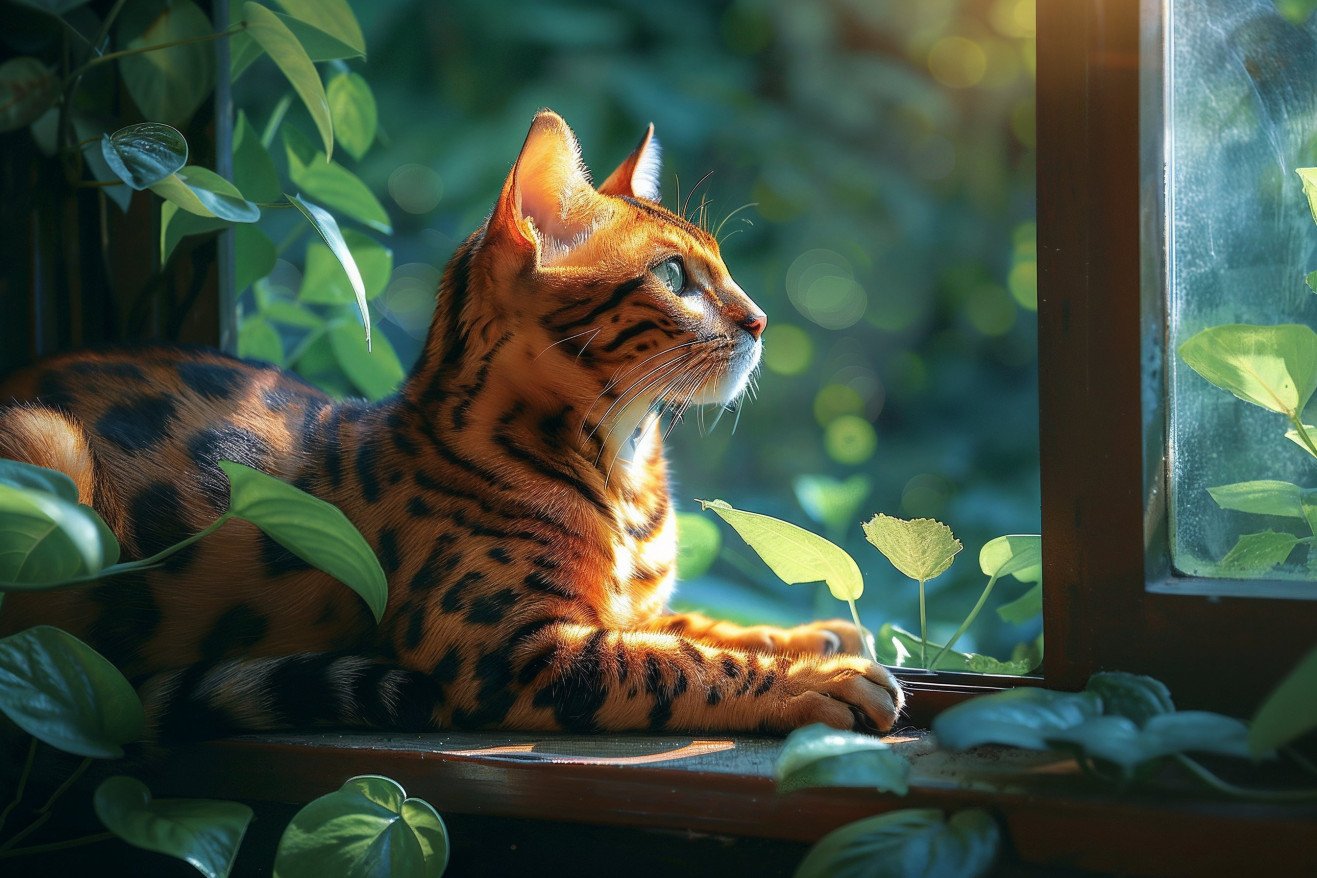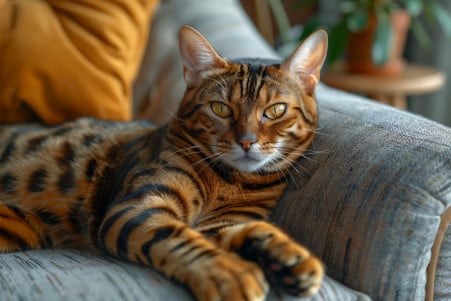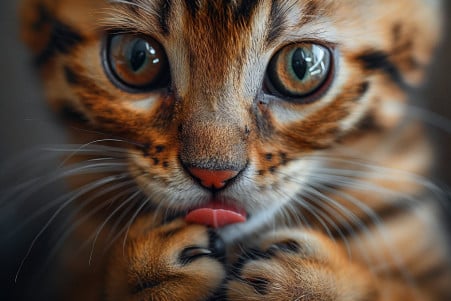How Long Do Bengal Cats Live? Bengal Cat Lifespan
9 April 2024 • Updated 8 April 2024

Bengal cats, with their beautiful coats and wild appearance, are known for their unique looks and personalities. But how long do these exotic hybrid cats typically live? When kept indoors, the average life expectancy of a Bengal cat is 12-16 years. With the right care, diet, and environmental stimulation, which is especially important for their active nature, healthy Bengals may live to the high end of that range or even longer.
In order to understand how long Bengal cats live, it's important to consider the factors that impact their life expectancy, including their genetics, housing requirements, and preventive care. By referencing veterinarians, long-time Bengal cat parents, and learning more about the breed's history, we can learn more about the best practices for ensuring that these wild-looking feline friends live long, healthy lives.
How long do Bengal cats live?
Potential Genetic Health Issues and How to Prevent Them
Bengal cats are susceptible to a number of genetic health problems that could potentially affect their life expectancy. According to Catster, these include progressive retinal atrophy (PRA), which can lead to blindness, patellar luxation (dislocated kneecaps), and hypertrophic cardiomyopathy (HCM), a type of heart disease. Other potential issues include chronic renal failure, gastritis, lymphoma, pancreatitis, and feline lower urinary tract disease (FLUTD).
To help ensure a long life, PetMD says it's important to make sure your cat gets regular veterinary care, eats a high-quality diet, and has an enriched environment that includes plenty of exercise and mental stimulation. It's also important to make sure that breeders are responsible and that they genetically test for conditions like PK-Def, Bengal PRA, and HCM to help ensure the health of the cats they breed.
By catching and addressing any health problems early, you can help make sure these beautiful cats live long, healthy lives. By making sure your cat gets the right preventative care for its specific needs as a breed, you can help ensure that your Bengal cat lives as long and as well as possible.
How to Take Care of a Bengal Cat: Feeding, Exercise, and More
Bengal cats have specific dietary requirements and are best fed a diet that is high in protein and fat and made up of animal-based ingredients. Untamed explains that a meat and fish-based diet is best because these cats need animal protein to maintain a healthy weight and high energy levels. In addition, the right nutrients, including essential fatty acids, can help prevent inflammatory issues like arthritis and allergies.
Meeting the needs of a Bengal's active and intelligent personality means providing plenty of vertical space, scratching posts, and environmental stimulation. The Bengal Connection says that cat trees, hammocks, and access to windows are important to satisfy their natural urge to climb. In addition, providing interactive toys and training can help meet their need for physical and mental stimulation.
Bengals need lots of exercise and mental stimulation to keep them from becoming obese and acting out. PetHelpful explains that this can include walking the cat on a leash and harness and playing with them for at least 30 minutes in the morning and 30 minutes in the evening. Proper grooming, litter box care, and socialization (with another cat or a dog) can also help ensure a Bengal's well-being.
With the right environment, diet, and exercise, Bengal cat owners can help their cats live long, healthy lives. It's important to know their needs and be aware of the potential pitfalls of bringing a Bengal into a home with kids.
Are Bengal Cats Good With Children?
Bengal cats can be good pets for families with children if they are introduced to kids properly and interactions are supervised. As reported by Green Matters, Bengal kittens are generally more adaptable to living with children, while older Bengals may need a longer adjustment period to get used to living with kids.
It's important to teach children to recognize a cat's body language and to interact with the cat in a way that is respectful and positive. As explained by Registered Bengals, one way to do this is to help kids learn to recognize a cat's mood by paying attention to its tail. In addition, making sure the cat has vertical territory and a safe space to escape to can help ensure that the cat feels safe and secure in the home.
Playing with the cat can also help kids bond with the cat. Quality Bengal Kittens suggests that kids can play games with the cat, such as chase, fetch, and hide-and-seek, to help the cat get the exercise it needs. With the right introductions and supervision, Bengal cats can be a great addition to a family.
The Financial Commitment: Bengal Cat Ownership Costs
The cost of a Bengal cat from a reputable breeder can range from $1,500 to $3,000 or more, depending on the breeder and the cat’s bloodline, according to Catster. Meanwhile, adoption fees for Bengal cats or Bengal mixes can be anywhere from $100 to $500, although purebred Bengals are hard to find in shelters and rescues, according to Spot.
However, the initial costs of getting a Bengal cat go beyond the price of the cat. In addition to supplies, spaying/neutering, and veterinary care, the total can be another $300 to $500, according to Spot. Meanwhile, monthly costs for food, litter, toys, grooming, and possibly pet insurance can be $50 to $200 or more, according to Belle Ami Bengals.
Because Bengals are prone to certain health problems, pet insurance is something that owners may want to consider. As mentioned by Spot, Bengal owners often file claims for a variety of issues, which shows how much it can cost to care for these beautiful cats.
Although the costs of getting and caring for a Bengal cat can be high, it’s important to know what you’re getting into financially before you decide to bring one into your life. This will help you as you move on to the next section, which covers the legalities of Bengal cat ownership.
Legal Considerations: Laws Regarding Bengal Cat Ownership
In the United States, many states have placed outright bans on Bengal cats due to their hybrid status. According to Catster, Hawaii, Maryland, and Connecticut have all banned the ownership of Bengal cats. Meanwhile, other states like Delaware and Georgia have permits and specific rules in place based on the cat's generation and lineage from the Asian Leopard Cat.
In addition to state laws, there are also local laws in place that restrict Bengal cat ownership, such as in New York City and Seattle, where they are banned. As pointed out by Green Matters, the laws surrounding Bengal cat ownership are incredibly inconsistent, with some places allowing them with certain restrictions and others banning them altogether.
Anyone considering getting a Bengal cat should make sure to research and follow all relevant state and local laws regarding the ownership of this hybrid breed. Knowing the legalities is important before you decide to bring a Bengal cat into your home. This will help ensure that your Bengal cat has the best chance at a happy life.
Conclusion: How to Give Your Bengal Cat a Happy Life
With their exotic looks and active personalities, Bengal cats can be great pets for the right people. However, it's important to be aware of their specific needs, as well as the potential health and legal issues that can come with owning a Bengal cat, to ensure that you can give them the best life possible.
A good diet, lots of mental and physical stimulation, regular vet care, and ethical breeding are all important factors in helping Bengal cats live long, healthy lives. While the cost of ownership can be high, the joy of having a happy, healthy Bengal cat can make it all worthwhile for those who can provide for them.
By heeding expert advice and making sure that their home is the best it can be, Bengal cat owners can look forward to many years with their beloved pets.


